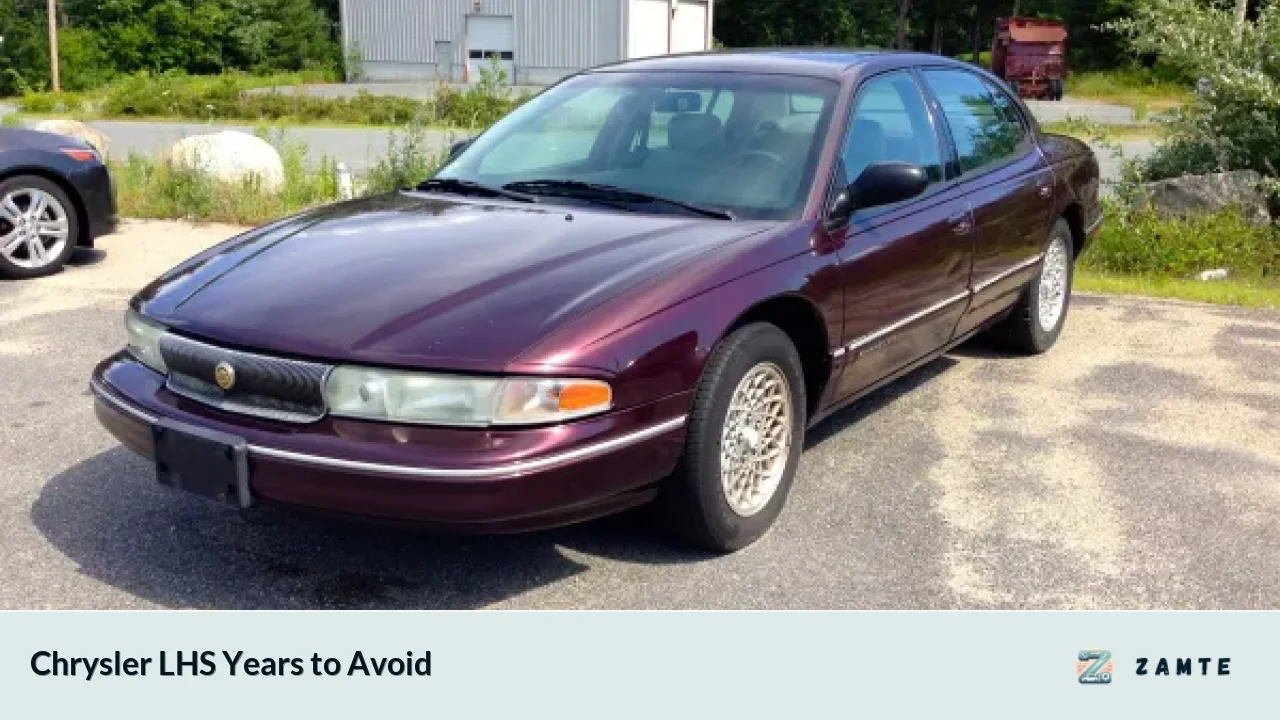The Chrysler LHS, a full-size luxury sedan produced from 1994 to 2001, was known for its spacious interior and comfortable ride. However, like many vehicles, certain model years were plagued with issues that potential buyers should be aware of. This comprehensive guide will help you navigate the best and worst years of the Chrysler LHS, focusing on common problems and years to avoid.
| Model Year | Reliability Rating | Common Issues |
|---|---|---|
| 1994-1995 | 3/5 | Transmission problems, electrical issues |
| 1996-1997 | 2/5 | Engine failures, suspension wear |
| 1998-1999 | 3.5/5 | Cooling system leaks, minor electrical problems |
| 2000-2001 | 2.5/5 | Transmission failures, suspension issues |
The Most Problematic Years: 1996-1997 and 2000-2001
The 1996-1997 and 2000-2001 model years of the Chrysler LHS are generally considered the most problematic and are best avoided by used car buyers[1]. These years experienced a higher frequency of serious issues that could lead to expensive repairs and frustrating ownership experiences.
1996-1997 Models: These years were particularly troublesome due to frequent engine failures and premature suspension wear. Many owners reported engine problems that resulted in complete engine replacements, a costly repair that could easily exceed the value of the vehicle. Additionally, the suspension components in these models tended to wear out faster than expected, leading to poor handling and expensive repairs.
2000-2001 Models: The final two years of LHS production also had their share of problems. The most significant issue was transmission failure, which was reported by numerous owners[1]. Transmission repairs or replacements can be extremely costly, often running into thousands of dollars. These models also continued to suffer from suspension problems, with many owners complaining about premature wear of components like ball joints and control arms.
Common Problems Across All Years
While some years were worse than others, the Chrysler LHS had several recurring issues throughout its production run:
1. Transmission Failures
Transmission problems were a persistent issue for the LHS, particularly in later models. Symptoms often included rough shifting, slipping gears, and complete transmission failure[2]. Regular maintenance and fluid changes could help mitigate these issues, but many owners still experienced premature transmission failure.
2. Electrical System Malfunctions
Electrical problems were common across all model years of the LHS. These ranged from minor annoyances like faulty power windows to more serious issues affecting the vehicle's operation[1]. Some owners reported problems with the instrument cluster, power locks, and even engine management systems.
3. Suspension Wear
The LHS was known for its comfortable ride, but this came at the cost of suspension components that wore out faster than expected. Ball joints, control arms, and struts were common failure points, leading to poor handling, uneven tire wear, and potentially dangerous driving conditions if left unaddressed.
4. Cooling System Leaks
Many LHS owners reported issues with the cooling system, particularly in the 1998-1999 models[1]. Leaks from the radiator, water pump, and various hoses were common. These leaks could lead to overheating if not addressed promptly, potentially causing severe engine damage.
The Better Years: 1998-1999
While no model year of the LHS was without its issues, the 1998-1999 models are generally considered the most reliable[1]. These years benefited from improvements made to address earlier problems and had fewer reported issues overall. However, potential buyers should still be aware of the common problems mentioned above and have any used LHS thoroughly inspected before purchase.
Maintenance Tips for LHS Owners
If you already own a Chrysler LHS or are considering purchasing one, here are some maintenance tips to help prolong the life of your vehicle:
- Regular transmission service: Frequent fluid changes and inspections can help prevent transmission failures.
- Suspension checks: Have the suspension components inspected regularly and replace worn parts promptly.
- Cooling system maintenance: Keep an eye on coolant levels and address any leaks immediately to prevent overheating.
- Electrical system care: Address electrical issues as soon as they appear to prevent more serious problems from developing.
Conclusion
While the Chrysler LHS offered luxury features and a comfortable ride, its reliability issues make it a risky choice for used car buyers. The 1996-1997 and 2000-2001 model years are particularly problematic and should be avoided if possible. If you're considering an LHS, the 1998-1999 models are generally the safest bet, but even these should be approached with caution and thoroughly inspected before purchase.
Remember, individual experiences can vary, and proper maintenance can significantly extend the life of any vehicle. However, given the known issues with the LHS, potential buyers might want to consider more reliable alternatives in the full-size luxury sedan market.
FAQs
- What are the worst years for the Chrysler LHS?
The 1996-1997 and 2000-2001 model years are generally considered the most problematic due to frequent engine, transmission, and suspension issues. - Are there any good years for the Chrysler LHS?
The 1998-1999 models are generally considered the most reliable, but they still have some common issues to be aware of. - What is the most common problem with the Chrysler LHS?
Transmission failures are one of the most common and costly problems, especially in later models. - How long does a Chrysler LHS typically last?
With proper maintenance, an LHS can last over 150,000 miles, but many experience significant issues before reaching this milestone. - Is the Chrysler LHS expensive to maintain?
Yes, the LHS can be expensive to maintain due to frequent issues with major components like the engine, transmission, and suspension.
🎉 New releases: Volvo 960 Years to Avoid and What You Need to Know
📌 Noteworthy reads: Chevrolet Express Years to Avoid and What You Need to Know
📰 Relevant news: Worst Saturn SL2 Model Years: What to Know
